
Echeveria: planting, growing and caring
Contents
Echeveria in a nutshell
- Echeveria is a charming little succulent plant
- It forms rosettes of thick, waxy leaves
- Its leaves can take on a wide variety of hues: light green, bluish, pale grey, purple, red, orange…
- It is graphic and highly decorative for creating succulent plant compositions
- It thrives in full sun and well-draining soil
The word from our expert
Echeveria is a small succulent plant that forms beautiful rosettes of imbricate leaves. There are around 250 botanical species and numerous horticultural varieties, offering a great diversity of shapes and colours! The leaves are often triangular, ovate, or spatulate, and vary in width depending on the species. They can be green, grey, bluish, purple, reddish, brown-black, and sometimes display several shades of colour.
Echeverias are easy-to-grow plants and require minimal maintenance. They need a well-draining substrate and are drought-resistant. Their only drawback is their lack of hardiness: they can only be grown outdoors in regions unaffected by frost, such as the Mediterranean coast. In other areas, they should be grown in pots so they can be brought indoors for winter and placed outside on the terrace or balcony in spring once the risk of frost has passed. Discover all our tips for successfully growing Echeverias!
Botany and description
Botanical data
- Latin name Echeveria sp.
- Family Crassulaceae
- Common name Echeveria
- Flowering spring or summer
- Height between 5 and 30 cm
- Exposure full sun or light shade
- Soil type well-drained, sandy or stony
- Hardiness generally between 0 and 5 °C, but down to -4°C for the hardiest
Echeverias comprise around 250 species native to the dry and desert regions of Mexico and western South America. They are succulent plants, also known as fleshy plants, as they store water and minerals in their tissues (specifically in their leaves), much like cacti, agaves, aloes, and sedums. This allows them to survive in particularly arid environments and withstand periods of drought.
Echeverias form rosettes of fleshy leaves that somewhat resemble those of houseleeks, though they are not as hardy. Most are sensitive to temperatures below 5 °C and must be protected in winter. The Echeveria pulvinata is one of the most cold-resistant species, capable of enduring between –4 and –8 °C.
In addition to the many existing botanical species, horticulturists have created a large number of cultivars through hybridisation, prized for their unique shapes and colours, making them highly ornamental.
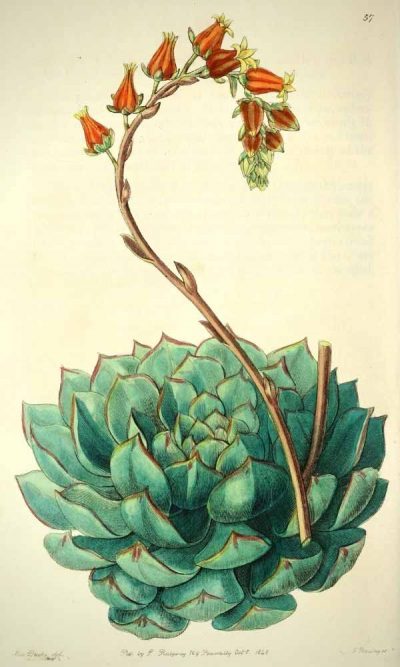
Echeveria secunda: Botanical illustration
Echeveria was named in honour of the Mexican botanist and naturalist illustrator Atanasio Echeverria y Godoy (1771–1803).
Forming their rosettes directly at ground level, Echeverias are small-sized plants. Depending on the variety and the age of the plant, they reach between 5 and 30 cm in height. Most Echeverias spread over time, forming new rosettes alongside the original one. Some species are shrubby, developing branched stems with a rosette at their tip.
Echeverias produce thick, succulent leaves with a waxy appearance. Their leaves are often spatulate or triangular, broad and tapered at the tip, though some species have narrower leaves. Sometimes the leaves are very regularly imbricate, forming a harmonious rosette or spiral pattern. This is the case, for example, with Echeveria derenbergii and Echeveria secunda var. glauca. Others may take on a very peculiar and “misshapen” appearance, such as Echeveria gibbiflora ‘Carunculata’ or Echeveria agavoides ‘Cristata’—true botanical curiosities! Like other succulents, the fleshy leaves of Echeverias allow them to store water and minerals to survive periods of drought.
The leaves of Echeverias come in a wide range of colours depending on the variety: they can be light green, bluish, purplish, light grey, reddish, or purple. They often feature multiple shades: it is common, for instance, for leaves to be green with red tips or edges. Some species are very dark, such as Echeveria affinis, Echeveria ‘Black Prince’, and Echeveria ‘Black Knight’, with their black leaves. Echeveria ‘Afterglow’ surprises with its blue-purple hue, edged in pink! As for Echeveria nodulosa, it bears variegated leaves, green marked with dark red, as if painted. But the most astonishing variety is undoubtedly ‘Trumpet Pinky’, with its trumpet-shaped pink leaves tinged with blue-violet! You can have fun creating colour contrasts by combining Echeverias of different hues, such as a black, green, bluish, and red variety.

Echeverias come in a wide variety of shapes and colours! It’s interesting to combine several varieties to create beautiful compositions. Echeveria ‘Miranda’, Echeveria setosa var. minor, Echeveria ‘Etna’ (photos: Jean-Michel Moullec), Echeveria ‘Compton Carousel’ (photo: Seán A. O’Hara), Echeveria ‘Serena’ (photo: Leo González), Echeveria runyonii ‘Topsy Turvy’ (photo: Forest & Kim Starr), Echeveria ‘Curly Locks’ (photo: Mokkie), and Echeveria ‘Duchess Of Nuremberg’ (photo: Federico Arambarri)
There are even species with hairy leaves: for example, Echeveria bombycina and Echeveria setosa have green leaves covered in tiny white hairs. These hairs protect the plant from sunlight and drought while retaining moisture. These varieties are highly decorative, with their soft, delicate fuzz resembling frost on the leaves.
Echeverias flower in spring or summer. They then unfurl, above the rosette, a long flower stalk with a few small leaves, bearing at its tip tiny bell-shaped flowers, slightly inclined and barely open, usually yellow, orange, or red. The flowers are clustered in racemes or panicles. Each stalk can carry a dozen or more flowers, which open gradually from the bottom upwards. The flowers consist of five coloured petals forming the corolla tube, surrounded by five shorter sepals (calyx). At the centre of the flower, between the petals, are inserted 10 stamens (male reproductive organs), which carry pollen. They surround the pistil (female reproductive organ), located at the heart of the flower, which receives the pollen, enabling seed development. The flowering of Echeverias is appreciated for its delicate appearance, with its discreet little bells, and its warm yet gentle colour.

The flowering of Echeveria ‘Blue Curl’: inflorescence and flower detail (photos: J.J. Harrison), and the flowering of Echeveria elegans (photos: Hinnerk11 and Bff)
The main varieties of Echeveria
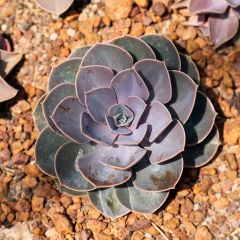
Echeveria Perle Von Nürnberg
- Flowering time August, September
- Height at maturity 15 cm

Echeveria lilacina
- Flowering time June, July
- Height at maturity 30 cm
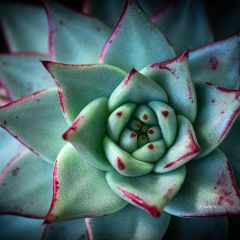
Echeveria agavoides Ebony
- Flowering time June, July
- Height at maturity 15 cm
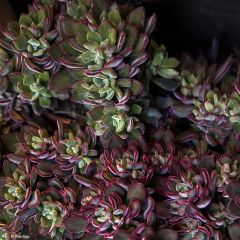
Echeveria Devotion
- Height at maturity 15 cm
Discover other Echeveria
View all →Available in 1 sizes
Available in 1 sizes
Available in 1 sizes
Available in 1 sizes
Available in 1 sizes
Available in 1 sizes
Available in 1 sizes
Available in 1 sizes
Available in 1 sizes
Available in 1 sizes
Planting Echeveria
Where to Plant?
Echeverias are generally not very hardy (the hardiest among them can withstand temperatures down to –5°C). Therefore, outdoor cultivation is best suited to the Mediterranean basin and sheltered areas of the Atlantic coast, where the risk of frost is low. In these regions, they can be planted in a rock garden or on a stone wall, which will ensure good drainage. They can also be incorporated into a dry exotic garden, alongside agaves, aloes, cacti, yuccas, and sedums…
In cooler climates, it is preferable to grow them in pots so they can be brought indoors for the winter and placed outside in summer, for example on a balcony or terrace.
Echeverias thrive in full sun, though they also tolerate light shade. It’s worth noting that sunlight enhances the colour of their foliage, especially in varieties with purple, pink, or reddish leaves. If grown indoors, we recommend placing them near a window. Otherwise, if they lack light, they may become leggy as they stretch upwards in search of light, which will make them less attractive.
Like all succulents, Echeverias require a well-draining substrate that does not retain moisture. They will appreciate being planted in a mix of garden soil and coarse sand. A specialised cactus compost will also suit them well.
Echeverias are also perfect for container gardening on balconies or terraces. They blend beautifully in compositions with other succulents, such as houseleeks, sedums, saxifrages, aloes, kalanchoes, and small cacti.
Echeverias can also be used in indoor living walls or plant displays.
When to Plant?
If planting in the ground, we recommend planting Echeverias in spring, around May. Similarly, if grown in pots, they can be repotted in spring.
How to Plant?
In the ground:
In Mediterranean regions, you can plant Echeverias in a rock garden, flower bed, or on a stone wall.
- Dig a planting hole.
- Fill the hole with a mix of compost, garden soil, and coarse sand.
- Plant the Echeveria.
- Replace the substrate around it, ensuring not to bury the collar or the first leaves.
- Lightly firm the soil.
- Water.
- You can add a thin layer of coarse sand or small gravel on the surface to isolate the collar and basal leaves from the compost, preventing rot.
→ Also read: How to plant succulents in the ground in the garden?
In pots:
We recommend growing Echeverias in terracotta pots, as these are permeable to water and air, promoting better root aeration and drainage. Alternatively, you can use a plastic pot. The most important thing is that it has drainage holes at the bottom to allow excess water to escape.
As for the substrate, it must be well-draining: for example, create a mix of 50% compost and 50% coarse sand. A specialised cactus compost can also work.
- Start by placing a layer of clay pebbles or gravel at the bottom of the pot to aid drainage.
- Add the substrate (ideally a mix of compost and coarse sand in equal parts).
- Place the Echeveria in the centre of the pot, ensuring not to bury the collar or the first leaves.
- Add more substrate around it and lightly firm.
- Optionally, add a thin layer of gravel or coarse sand on the surface. This not only looks decorative but also isolates the collar and first leaves from the moisture of the compost.
- Water lightly.
- Place the pot in a sheltered, bright location or outdoors in the sun if there is no risk of frost.
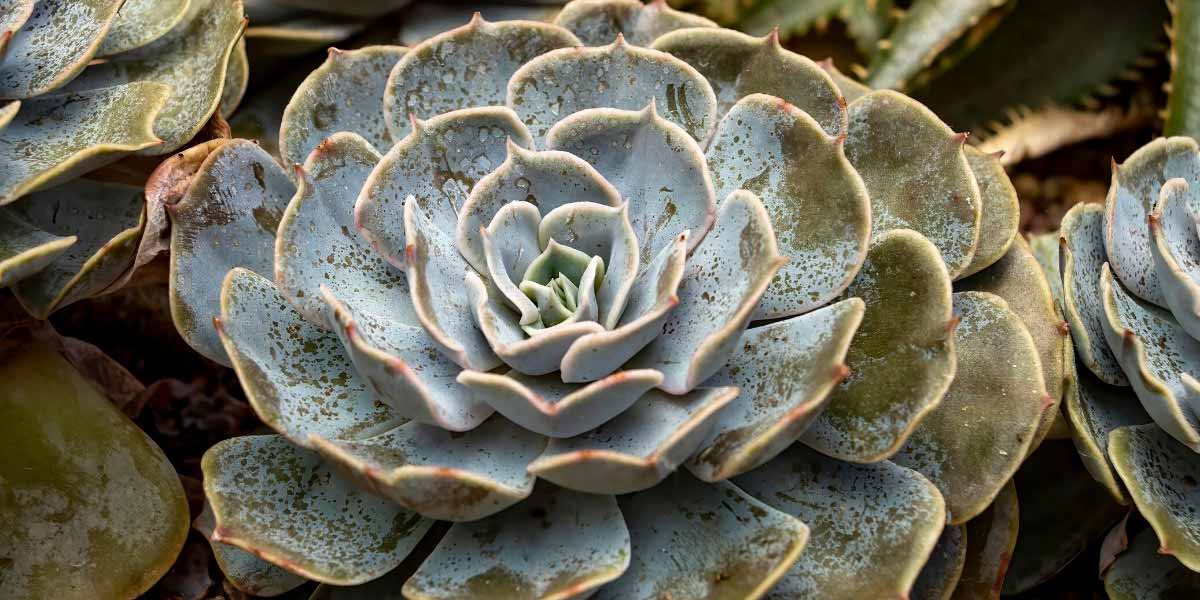
Maintenance
Like most succulents, Echeveria requires minimal maintenance. It is drought-resistant and, on the contrary, fears excess moisture, which risks rotting its roots. Water it moderately, allowing the soil to dry out between waterings. You can water it once a week to once every two weeks in spring and summer, with slightly more frequent watering during flowering (once a week). In autumn and winter, reduce watering to once a month. Be careful not to let water stagnate in the saucer or on the foliage, and always direct water onto the soil rather than onto the rosette of leaves.
If you grow Echeveria in a pot, we recommend moving it outdoors in spring, once there is no longer a risk of frost: place it, for example, on your terrace or balcony, so it can enjoy the sun. In autumn, remember to bring it indoors to protect it from the cold. It will thrive in a bright spot, at a temperature of at least 7°C. If the Echeveria lacks light, it will tend to become etiolated, producing abnormally long stems with spaced-out leaves, and will likely end up drooping.
We recommend repotting Echeveria every two years, in spring. Each time, choose a pot slightly larger than the previous one. If you notice dead or damaged leaves, take the opportunity to trim them. After repotting, wait at least a week before watering.
In spring and summer, don’t hesitate to add a little fertiliser specially formulated for succulents, at a rate of one application per month. This will encourage the plant to flower and grow by providing it with the necessary nutrients.
Echeverias are susceptible to mealybugs, especially when grown indoors. These sap-sucking insects can be identified by the presence of small, cottony white clusters on the leaves. They feed on the sap and weaken the plant, potentially leading to the appearance of sooty mould. You can remove them using a cotton swab dipped in 90% alcohol or soapy water. For more advice and information, check out our guide “Mealybugs: Identification and Treatment”.
Multiplication
Echeverias are easy to propagate by division or propagation by cuttings. Sowing is also possible.
Sowing
Be aware that if you harvest seeds from horticultural varieties, the young plants may not resemble the parent plants. It is preferable to propagate these varieties by propagation by cuttings or division to obtain genetically identical plants, reserving sowing for botanical species.
Sow the seeds in spring or early summer. It is best to use fresh seeds, recently harvested, as they will have a better germination rate.
- Fill a pot with a well-draining substrate, such as a mix of compost and coarse sand, or special cactus compost, then lightly tamp down and level the surface.
- As the seeds are very fine, we recommend mixing them with sand to make handling easier.
- Sprinkle the seed and sand mixture evenly over the substrate surface, ensuring it is distributed homogeneously.
- Mist the substrate lightly with water.
- Cover the pot with plastic film, punctured with a few holes for ventilation. This will help maintain a humid atmosphere, ideal for germination. Alternatively, you can use a mini greenhouse.
- Place the pot in a bright spot, out of direct sunlight. The ideal temperature is between 18 and 22 °C.
Echeveria seeds usually germinate within 2 to 3 weeks. Keep the substrate slightly moist until germination occurs. Once they have sprouted, you can remove the plastic film and reduce watering slightly.
Propagation by Cuttings
Echeverias can be easily propagated by leaf or stem propagation by cuttings.
- For a stem cutting, remove a rosette by cutting the stem a few centimetres below the rosette, using a clean, sharp knife. For a leaf cutting, simply detach a few leaves from the parent plant.
- Allow the leaf or stem to dry in the open air for a few days (this allows a callus to form over the wound).
- Prepare a pot with a well-draining substrate, such as cactus compost.
- If propagating a stem, make a small hole in the substrate using a thin stick or pencil, then plant the stem in the hole. For leaves, simply place them on the substrate surface.
- Water lightly.
- Place the pot in a sheltered, bright spot, protected from direct sunlight.
For more tips and information, check out our tutorial “Propagating Cacti and Succulents”.
Division of Offsets
Most Echeverias produce offsets—small new rosettes beside the original one. Simply remove and repot them to create new plants.
- Choose a well-developed plant that has produced offsets.
- Separate them by cutting the stolon close to the parent plant.
- Allow the new rosettes to dry in the open air for a few days to let the wound heal.
- Replant them in pots with a well-draining substrate.
- Water.
- Place the pot(s) in a sheltered, bright spot, out of direct sunlight.
These young plants will gradually grow and thicken, eventually producing new offsets of their own.
Association
A tender plant that thrives in mild climates, the Echeveria will fit perfectly into a Mediterranean garden. Pair it with other plants that love warmth and well-drained soil, such as agaves, yuccas, and prickly pears, which you can plant, for example, in a rockery or a mineral-themed setting. Discover the stunning Pride of Madeira, Echium fastuosum, which produces tall spikes of blue flowers in spring! Also consider palm trees, such as the Chamaerops humilis, with its bushy habit and large fan-shaped leaves. You can also include an olive tree, a true symbol of the Mediterranean, with its gnarled trunk and silvery foliage. For flowering plants, rely on rockroses, sunroses, oleanders, and agapanthus, which will add beautiful splashes of colour!
Explore our full range of perennials and Mediterranean bushes.
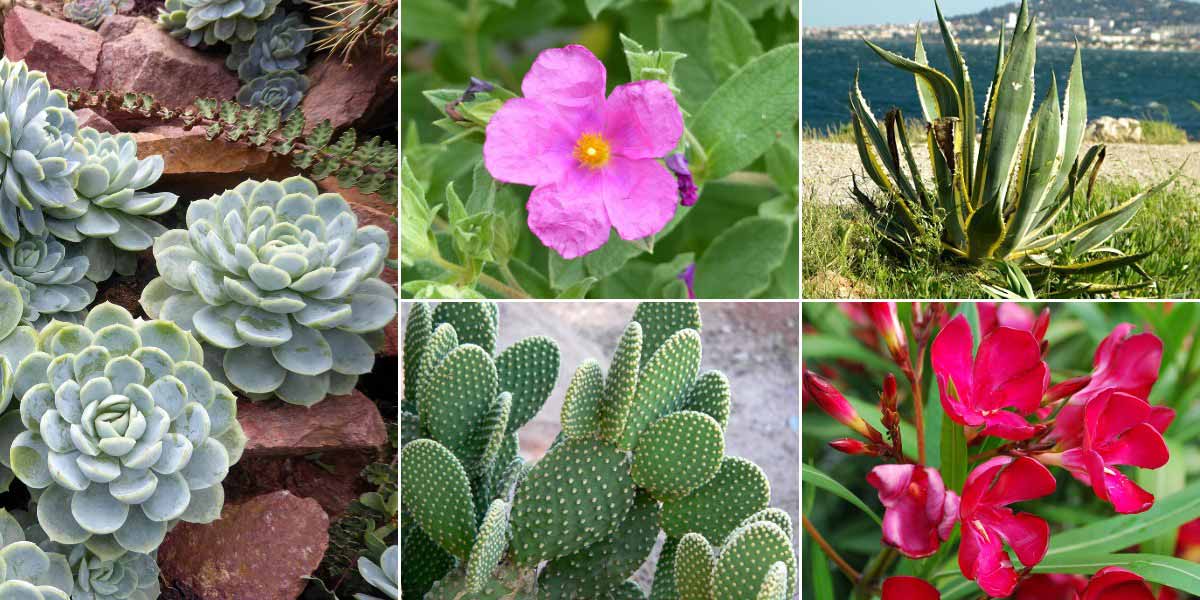
Echeveria elegans (photo: Syrio), Cistus x pulverulentus, Agave americana ‘Variegata’, Opuntia microdasys (photo: Stan Shebs), and Nerium oleander
You can also create a stunning potted arrangement by pairing Echeveria with other succulent plants: kalanchoes, aeoniums, haworthias, aloes, and sedums, to play with shapes and colours! Discover the Portulacaria afra ‘Variegata’, a delightful shrubby succulent with bonsai-like features and variegated foliage. As for Echeverias, we recommend combining different varieties, such as those in shades of purple-black, light green, blue, and red. You can place this arrangement on your balcony or terrace to enjoy during the summer and bring it indoors for winter to protect these plants from the cold.
Explore our full range of cacti and succulents.
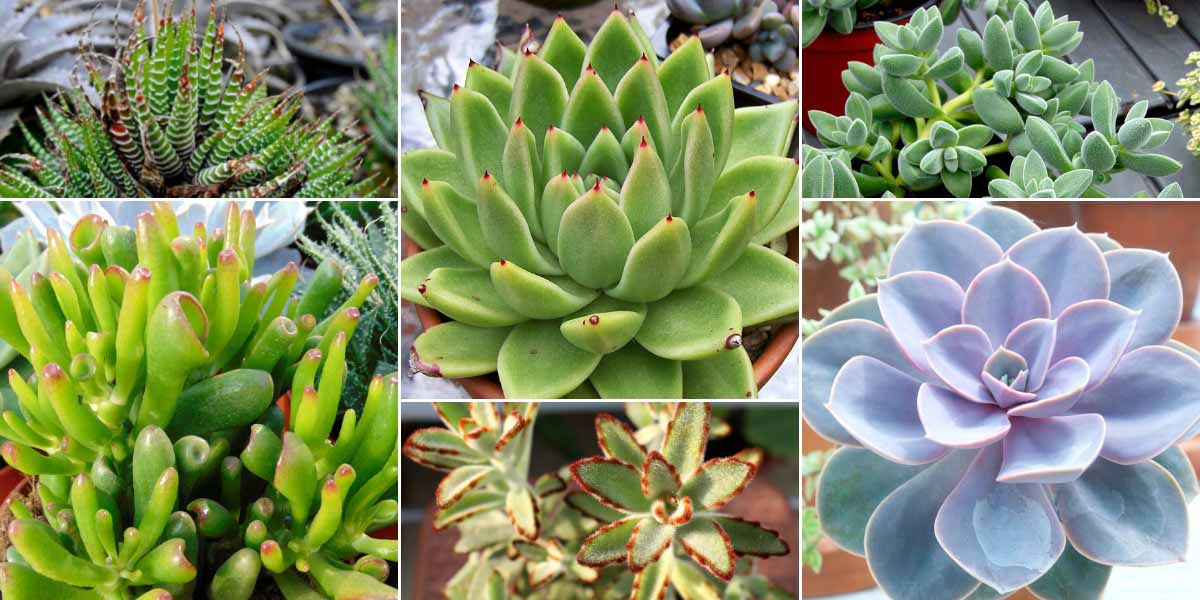
Haworthia zebrina (photo: Megan Hansen), Echeveria agavoides (photo: Stephen Boisvert), Crassula ‘Deceptor Jaldety’, Crassula ovata ‘Hobbit’, Kalanchoe tomentosa, and Echeveria ‘Perle Von Nurnberg’ (photo: Karl Thomas Moore)
Also worth reading
-
- Discover our full range of cacti and succulents
- Feel free to check out our articles “Which cacti and succulents for my garden?” and “Creating a dry exotic garden”
- Our tutorial: “Taking cuttings from cacti and succulents”
- Subscribe!
- Contents































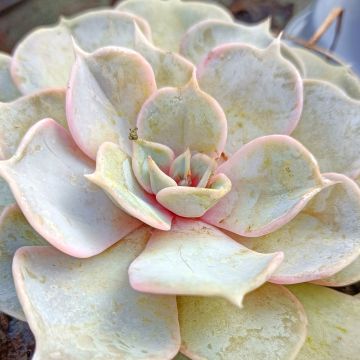


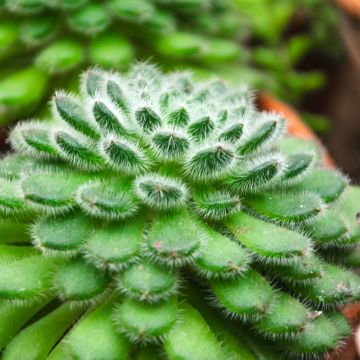
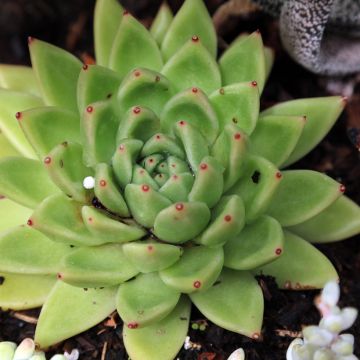

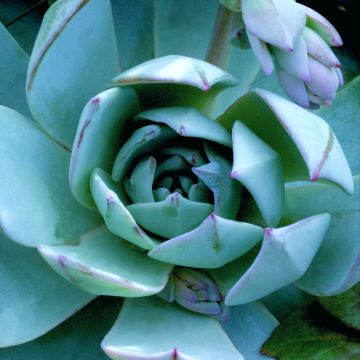
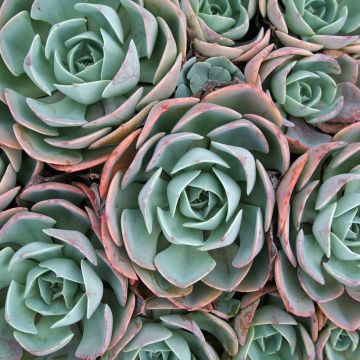


Comments